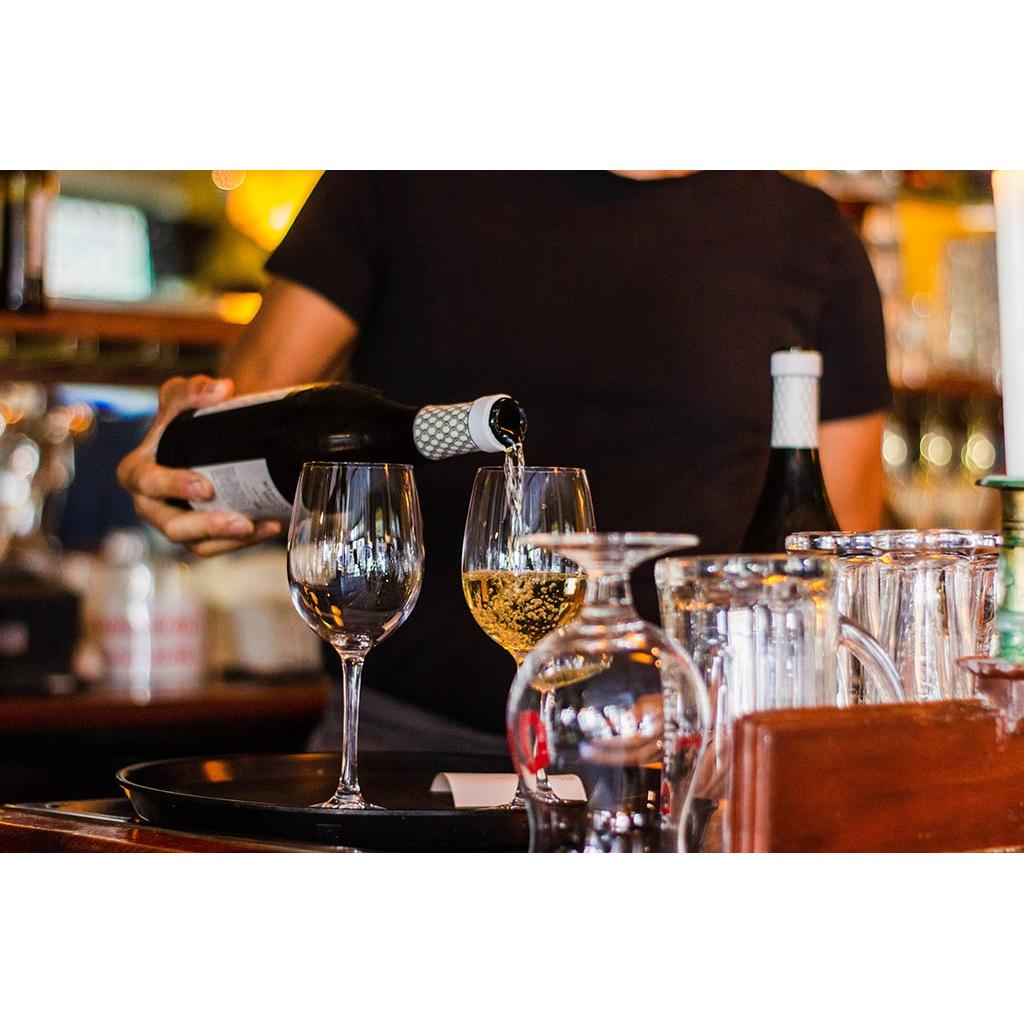Company
© Broadway Wine N Liquor.
Made by Brisbane.
Chardonnay is a green grape variety used to make the most popular wine variety in the world. Originating from the Burgundy region in France, Chardonnay is now grown all over the world, from the United States to Australia and is known as a ‘dry’ white wine. Discover more about Chardonnay wines.

Dry
Medium Body
Tannins
Medium Acidity
13.5 – 15% Alcohol Content (ABV)
Pineapple
Starfruit
Apples
Vanilla
Buttermilk
Serve at 45–55°F / 7-12°C
Glass Type: Aroma Collector
Decant: No
Cellar for 5-10 years
Get a bottle of Chardonnay delivered direct to your door. Over 6,000 bottles available now. Discover our entire range.
Chardonnay is the most planted white grape in the world and is as responsible for the dry steel white Chablis wines formed by gypsy soils, cool climate and extreme ripeness as for the power and irresistible texture of the Gran Cruz of the limestone soils of Cote de Bon. However, despite its greatness, it is surprising that Chardonnay is, by its very nature, a neutral grape variety, similar to a clean canvas that must be shaped according to grape and terroir choices.
1. The homeland of Chardonnay is Burgundy.
Chardonnay is originally from Burgundy, France, and has its name from a small town in Maconne, an area in southern Burgundy that produces relatively cheap and expensive chardonnay. Since the wine is now grown almost everywhere, and since we mark it by its variety and not by its place of origin, we tend to forget that names like Montrachet, Meursault, Pouilly-Fuisse and Chablis are synonymous with chardonnay.
2. Any bubbles? Same with Shardi.
Chardonnay is one of the three main varieties used in champagne, along with pinot noir (red) and pinot munier. Chardonnay is all blanc de blanc, and in my opinion, is the ultimate expression of grapes. Many New World sparkling wines also use a significant amount of Chardonnay.
3. This is the most popular white wine in America today.
According to the U.S. Department of Agriculture, in 2018, 93,148 acres of Chardonnay vines were planted in California. The most common white wine was French Columbari, far behind the 18,246 acres, followed by Pinot Gris and Sauvignon Blanc. Winegrowers love Chardonnay because it is easy to grow. And since their tastes are not as characteristic as other grape varieties such as Riesling or Sauvignon blanc, there is an “empty canvas” aspect to chardonnay that allows winegrowers to bend their technique and leave their own mark on the wine.
Thanks to the incredible variety of flavours and characteristics of Chardonnay (caused by the influence of climate and winemakers), Chardonnay is considered one of the most food-friendly wines. As a rule, Chardonnay blends well with white meat, seafood and vegetables. The style of chardonnay and the food fumes are further broken down.
Fruit, no oak or slightly oak Chardonnay.
Chardonnay with its mild, sometimes buttery taste of melon and peach combines perfectly with slightly saturated dishes where you can still enjoy some freshness from the wine. White meat and creamy sauces complement the butter content of the wine.
Chardonnay, full-bodied, oak-aged.
High quality chardonnay from the Margaret River, the Adelaide hills and the Yarra valley, aged or fermented in barrel form, can handle an additional degree of richness when combined with food. These wines can be perfectly combined with dishes such as Benedict eggs or Bearnaise steak.

Mature barrels fermented by Chardonnay.
Mature Chardonnay from 3 to 8 years of age has a creamier, sometimes nutty flavour, which requires finer, more delicate dishes that do not flood the wine’s flavour. Delicious dishes such as grilled or steamed clams, fried chicken, etc. are well combined.
France
Chardonnay appeared for the first time in the wine registers three centuries after Pinot Noir. The styles in France vary between regions and sub-regions. For example, there are three types of white burgundy: weak and crunchy, slightly oak and strongly oak and intense. Typical Burgundy Chardonnay flavours include apple, hazelnut, toffee and white flowers.
Italy
Chardonnay, and perhaps white wine in general, is not so much the focus of attention in Italy. Although there are some old Chardonnay vines scattered, and there is a renewed interest in this type of pig, supported by the success of the Australian Chardonnay. Some of the best examples come from Sicily and Umbria.
The United States of America
California has most of Chardonnay in America, especially in the Napa and Sonoma valleys, Carneros, as well as the Edna, Santa Maria and Santa Inez valleys. The states of Oregon and Washington also have chardonnay plantations.
New Zealand
Although Chardonnay was an important part of New Zealand wine production, it currently represents only three per cent of plantations. However, Gisborne and Hawkes Bay remain its champions. Waiheke Island also produces high quality and complex chardonnay, although they tend to have a high price tag.
Like all white wines, Chardonnay should be served fresh and chilled. If the wine is too hot, the alcohol tastes hot and the taste becomes confused. Too cold, and the tastes are silenced. The best temperature range is 50-55°F, which is reached in two hours in the refrigerator or 30-40 minutes in ice with cold water.

Chardonnay is originally from Burgundy, France, and has its name from a small town in Maconnay, an area in southern Burgundy that produces relatively cheap and expensive chardonnay.
Chardonnay is a word almost everyone has heard of, but few people really know what it means. It refers to the grape variety from which the wine is made, and that is probably how you have heard of the term. Chardonnay is one of the most common grape varieties in the world, since it was transferred from the Old World to the New World when America was discovered. Since then it has been grown almost everywhere in the world where wine is grown, including Australia, South America and Southeast Asia.
However, due to its popularity, Chardonnay has been overturned by many critics as they think nothing new can be done with the grapes anymore, but this may not be true. In this article we will follow Chardonnay’s story to learn more about how he got here and where future winemakers will take him. However, let’s get right to the point.
Where did Chardonnay Grapes come from?
Chardonnay is a green-skinned grape that was first grown in the region of the same name in southern Burgundy called Maconne. This is where the oldest Chardonnay vineyards are found, which has led many to believe that this is where all Chardonnay wines really come from. The heritage of Chardonnay grapes can be traced back thousands of years since the region was controlled by the Roman Empire. Despite periods of unrest in the area for many years, Chardonnay grapes still remained, and flourished and branched out into many different species. It is believed to be a cross between Pinot Noir and Gua Blanc, making it one of the oldest crosses in history.
The rise and rise of Chardonnay
There are many documents stating that Pinot Noir was considered the best grape and the price of these fruits was extremely high due to the complexity of the cultivation process. Pinot Noir is very sensitive to even the slightest changes in moisture levels and soil quality, which means that it is only available in a small part of the world. Gua Blanc, on the other hand, is very easy to cultivate, which is why the aristocrats of the time considered it a peasant wine. It is believed that some grape growers had the idea to cross these two grapes to create a type of high quality grape that is also easy to cultivate. The idea gave rise to many different breeds of grapes including Aligot, Hamay, Burgundy’s Day, Romorantine, Sassi and of course Chardonnay.
How do experts see Chardonnay?
Despite the decline in popularity, Chardonnay still occupies a place in the hearts of wine lovers around the world. Many consider it the Father of wine, as it is considered one of the oldest and most balanced wines in the world. Its slightly sweet and spicy taste makes it one of the easiest wines to drink, which is why some people call it the “Gateway Grape”. Most winemakers tend to make dryer wines with Chardonnay grapes, as its natural sugar content and mild acid profile allow the wine to be naturally sweet. In addition, its universal variation of the couple also makes it a very popular choice in restaurants, which reinforces its reputation as a generic wine. This has both positive and negative effects on grapes, as many experts see it as a sign of mediocrity, which is not fair given the potential of wine.
Chardonnay has a key place in the world of winemaking, as with this incredible wine we still have much to discover. As the style of this wine varies a lot depending on the winemaking and winemaking preferences, there is no other white wine that is proud of such patterns and styles. Chardonnay, in our opinion, is still the king among white wines. As a consumer, it is time to reintroduce yourself into Chardonnay and use a better understanding of it through practical means, the so-called drink more of its different price points and different regions, and you will also discover what you love.